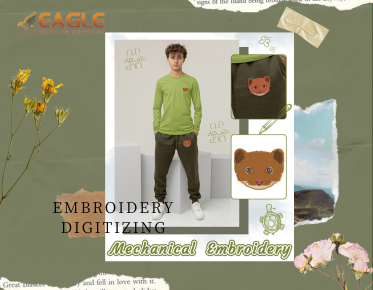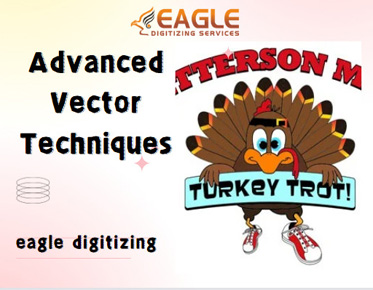From Tradition to Technology: How Machine Embroidery is Evolving
Embroidery has always been more than just a craft; it’s an art that has weaved itself into the fabric of human history. From ancient civilizations to today’s modern trends, this timeless craft has stood the test of time, constantly adapting to the needs of society. But in recent years, embroidery has entered a new era—one defined by the marriage of tradition and technology. With the rise of machine embroidery, what was once a labor-intensive, hand-crafted skill has evolved into a fast, precise, and mass-producible technique. And now, industries ranging from fashion to home décor are embracing this shift.
The
Origins of Embroidery: A Craft That Transcends Time
Embroidery’s origins trace back thousands of years, making it one of
the oldest and most universally recognized forms of textile art. Ancient
cultures from the Chinese dynasties to Egyptian pharaohs used embroidery to
showcase their social status, religious beliefs, and artistic skills. These
stitches told stories, conveyed meanings, and sometimes even held spiritual
significance. In medieval Europe, for example, elaborately embroidered
tapestries depicted stories of kings, battles, and mythology, while in Asia,
the embroidery was a mark of prestige, especially in garments worn by royalty.
In its earliest forms, embroidery was purely a manual process. Skilled
artisans used needles and thread to create intricate designs by hand, often
taking weeks, months, or even years to complete a single piece. This
labor-intensive process was reserved for the wealthy and powerful, as the time
and skill required made embroidered items rare and valuable.
The
Advent of Machine Embroidery: A Revolution in Stitches
The Industrial Revolution of the 19th century brought significant
technological advances, one of which was the development of the first machine
for embroidery. These early machines, like the hand-cranked embroidery machines
from the 1800s, drastically altered the landscape of textile production. They
allowed for the mass production of embroidered designs, making what was once an
expensive, time-consuming art form accessible to a much wider audience.
By the mid-20th century, machine embroidery had evolved into a highly
efficient process. The advent of electric and computerized machines meant that
designs could be reproduced at a scale and speed previously unimaginable. The
shift from handmade to machine-made embroidery was not just about speed, it
also brought about precision. Automated systems ensured that every stitch was
uniform, consistent, and perfect—a feat that even the most skilled artisan
struggled to replicate consistently.
Understanding
Modern Embroidery Machines: The Heart of Innovation
Today’s embroidery machines are technological marvels that combine
speed, precision, and versatility. From simple logos to complex, multi-layered
designs, modern machines can do it all. These machines work by creating a
series of highly controlled, intricate stitches that form the final design.
Unlike hand embroidery, which requires constant attention, a well-programmed
machine can work on its own, allowing businesses to produce thousands of items
with minimal supervision.
The machines themselves have come a long way. While earlier models
were limited to basic designs, today’s multi-needle machines can handle up to
15 needles, each one loaded with a different thread color, allowing for highly
detailed and colorful designs to be stitched seamlessly. The use of rotary
hoops in some models means that even the most intricate patterns can be
embroidered with incredible accuracy.
The
Role of Software in Machine Embroidery: Where Art Meets Technology
Behind every stunning machine-embroidered piece is powerful embroidery design software. These programs serve as
the bridge between creativity and automation, allowing artists and designers to
create digital files that tell the machine exactly how to stitch the design. Digitizing
artwork into a format that the embroidery machine can read is a complex process
that involves converting images or logos into stitches, and setting the stitch
direction, type, and density.
Embroidery software also allows for customization and
fine-tuning—designers can experiment with different stitch types, thread
colors, and patterns before sending the final design to the machine. In
essence, the software allows for a marriage of art and technology, making
embroidery an increasingly accessible and scalable form of creative expression.
Machine
Embroidery Techniques: A Closer Look at the Methods
Machine embroidery comes with a range of techniques that allow for
endless creative possibilities. One of the key distinctions is between flatbed
embroidery and cylindrical embroidery. Flatbed machines, which are typically
used for smaller, flatter items such as shirts or patches, have a stationary
hoop that holds the fabric in place while the needle moves across it.
Cylindrical machines, on the other hand, are designed for curved or tubular
objects like hats, sleeves, and cuffs, offering greater flexibility for
three-dimensional designs.
Within these methods, there are a variety ofstitches that bring designs to life. Satin stitches, for example, are
used for smooth, shiny lines, while fill stitches create solid areas of color.
Specialty machines have taken embroidery to new heights, enabling fine details
such as small text or intricate patterns to be reproduced with the utmost
precision.
The
Efficiency Factor: Why Machine Embroidery Is Preferred Over Handcrafting
The primary draw of machine embroidery is efficiency. Handcrafting a
detailed embroidered design can take days or even weeks. But with a machine,
what would traditionally be a laborious process can now be completed in a
fraction of the time. Modern embroidery machines can complete an intricate
design in a matter of minutes, making them ideal for businesses that need to meet
large-scale demands.
Another factor in their appeal is consistency. Machines guarantee
uniformity across every piece, ensuring that each stitch is identical. This is
especially valuable for commercial industries like fashion or corporate
branding, where high-quality and repeatable designs are essential.
Customization
Through Machine Embroidery: Personalizing the Ordinary
Machine embroidery has revolutionized the world of customization.
Businesses now can create highly personalized products quickly and at scale.
Whether it’s a custom logo on a corporate shirt or a unique design on a gift,
machine embroidery makes it possible to add personal touches to everything from
clothing to home décor.
Small businesses, in particular, have found a niche by offering custom
embroidered products. From personalized towels and bags to embroidered jackets
and hats, machine embroidery has opened up endless opportunities for
entrepreneurs looking to stand out in a crowded market.
Machine
Embroidery in Fashion: Bridging Tradition with Trend
Machine embroidery has made a strong return to the fashion scene,
blending traditional techniques with modern design trends. High-end fashion
designers have turned to embroidery to add texture, depth, and intricate
patterns to their collections, using machines to createelaborate designs at a pace that would be impossible by hand.
But it’s not just about aesthetics—machine embroidery also offers a
more sustainable approach to fashion. The precision and efficiency of modern
machines mean less waste, both in terms of materials and time, making it an
eco-friendly alternative to some other forms of garment decoration.
The
Digital Age of Embroidery: DIY Machines and Home-Based Businesses
The rise of home-based embroidery machines has empowered DIY
enthusiasts and small business owners to tap into the creative potential of
machine embroidery. Machines that were once reserved for large-scale production
are now accessible to individuals and entrepreneurs, making it easier than ever
to create personalized items from the comfort of home.
The popularity of platforms like Etsy has seen an influx of small
businesses using machine embroidery to create unique, custom products. From
monogrammed gifts to custom apparel, these home-based entrepreneurs are
transforming their passion into profitable side hustles.
From
the Industrial Age to the Information Age: How Machines Have Changed the Game
The shift from handcraft to machine-based embroidery has allowed the
textile industry to scale at unprecedented levels. The demand for automation
and efficiency has made machine embroidery an essential part of fashion,
sportswear, and branding. Custom logos, team jerseys, and corporate giveaways
are all created using automated embroidery machines.
What once required a skilled artisan working for hours or days can now
be completed in mere minutes, allowing businesses to meet the demands of a
global market.
Environmental
Impact: Is Machine Embroidery More Sustainable?
As industries become increasingly concerned with sustainability,
machine embroidery has shown its potential as an eco-friendly option. Modern
machines use precise stitching, minimizing thread waste and reducing the need
for excess material. Additionally, the development of sustainable fabrics and
threads has made it possible to create environmentally responsible embroidered
products.
While no industry is without its environmental impact, machine
embroidery stands out as a more efficient, less wasteful alternative to many
other methods of textile decoration.
The
Challenges of Machine Embroidery: What Are the Drawbacks?
Despite its many benefits, machine embroidery isn’t without its
challenges. Learning to master both the software and the machines themselves
can be a steep learning curve for newcomers. High-quality embroidery machines
can also come with a hefty price tag, making them a significant investment for
businesses or hobbyists.
Maintaining embroidery machines is another consideration. These
complex pieces of machinery require regular upkeep to ensure they continue to
perform at their best. While the benefits often outweigh the drawbacks, it’s
important to be aware of these factors when considering machine embroidery.
The
Global Influence of Machine Embroidery: A Universal Art Form
Machine embroidery has transcended borders, becoming a global form of
artistic expression. From Asia to Africa, embroidery connects people through
design, with different cultures incorporating unique symbols, colors, and
techniques into their works. The beauty of machine embroidery lies in its
ability to adapt traditional techniques while embracing new technologies,
allowing artists worldwide to collaborate and innovate in exciting ways.
The
Future of Machine Embroidery: What's Next?
As technology continues to evolve, so too will machine embroidery. The
integration of artificial intelligence and machine learning could potentially
lead to even greater precision and customization in the future. Additionally, 3D embroidery and interactive designs are beginning to
emerge, promising to revolutionize the industry even further.
The possibilities are endless, and the future of machine embroidery
looks incredibly bright.
Machine
Embroidery and the Crafting Community: How Technology Inspires Creativity
Embroidery, once seen as a traditional craft, has become an outlet for
contemporary creativity. Artists are now pushing the boundaries, using machine
embroidery to create intricate works of art. These artists are utilizing
technology to explore new patterns, textures, and materials, making embroidery
a modern form of self-expression.
Combining
Traditional Handcraft with Modern Technology: The Best of Both Worlds
In many ways, the future of machine embroidery lies in blending the
old with the new. Many artisans are incorporating hand-stitched elements into
their machine-made designs, giving their work a personal touch while still
benefiting from the speed and precision of modern machines. This hybrid
approach creates a beautiful balance between traditional craftsmanship and
cutting-edge technology.
The
Role of Machine Embroidery in Branding and Marketing
For brands looking to make an impact, machine embroidery has become an
essential marketing tool. Custom embroidered items
such as branded apparel, caps, and bags are a popular way for companies to
promote their logos and messages. The durability and premium feel of
embroidered products also make them highly effective for giveaways and
corporate gifts.
The
Continuing Evolution of Machine Embroidery
Machine embroidery is no longer just a relic of the past; it’s a thriving, evolving art form that bridges tradition with modern innovation. As the world continues to embrace technology, machine embroidery will continue to adapt, offering new possibilities for creative expression, business innovation, and sustainability. The future of this craft is bright, with endless opportunities to innovate while staying true to its rich historical roots.
 Embroidery Digitizing.png)


